Sony RX100 VI vs Panasonic FZ150
The Sony Cyber-shot DSC-RX100 VI and the Panasonic Lumix DMC-FZ150 are two digital cameras that were revealed to the public, respectively, in June 2018 and August 2011. Both the RX100 VI and the FZ150 are fixed lens compact cameras that are based on an one-inch (RX100 VI) and a 1/2.3-inch (FZ150) sensor. The Sony has a resolution of 20 megapixels, whereas the Panasonic provides 12 MP.
Below is an overview of the main specs of the two cameras as a starting point for the comparison.

Check RX100 VI offers at
ebay.com

Check FZ150 offers at
ebay.com
Going beyond this snapshot of core features and characteristics, what are the differences between the Sony Cyber-shot DSC-RX100 VI and the Panasonic Lumix DMC-FZ150? Which one should you buy? Read on to find out how these two cameras compare with respect to their body size, their imaging sensors, their shooting features, their input-output connections, and their reception by expert reviewers.
Body comparison
The side-by-side display below illustrates the physical size and weight of the Sony RX100 VI and the Panasonic FZ150. The two cameras are presented according to their relative size. Three successive views from the front, the top, and the rear are shown. All width, height and depth dimensions are rounded to the nearest millimeter.
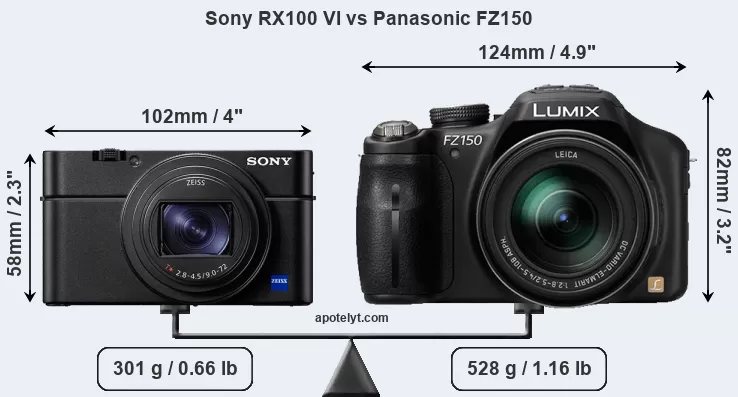
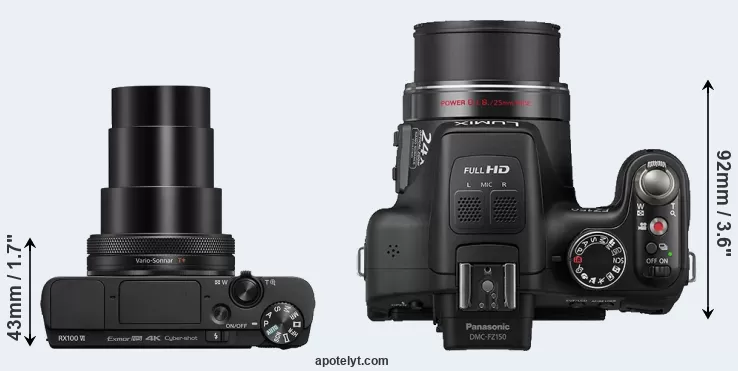
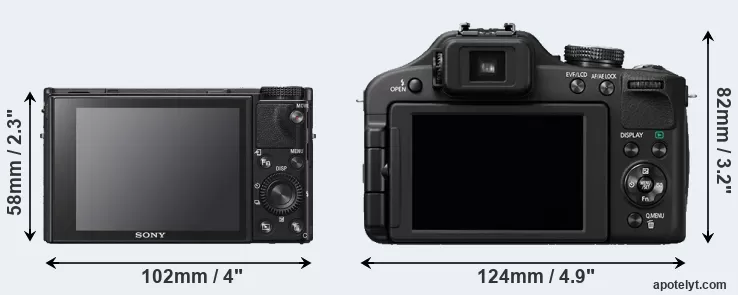
If the front view area (width x height) of the cameras is taken as an aggregate measure of their size, the Panasonic FZ150 is considerably larger (72 percent) than the Sony RX100 VI. Moreover, the FZ150 is substantially heavier (75 percent) than the RX100 VI. In this context, it is worth noting that neither the RX100 VI nor the FZ150 are weather-sealed.
Concerning battery life, the RX100 VI gets 240 shots out of its Sony NP-BX1 battery, while the FZ150 can take 410 images on a single charge of its Panasonic DMW-BMB9 power pack. The power pack in the RX100 VI can be charged via the USB port, so that it is not always necessary to take the battery charger along when travelling.
The adjacent table lists the principal physical characteristics of the two cameras alongside a wider set of alternatives. If you want to switch the focus of the display and review another camera pair, you can move across to the CAM-parator tool and choose from the broad selection of possible camera comparisons there.

| Camera Model |
Camera Width |
Camera Height |
Camera Depth |
Camera Weight |
Battery Life |
Weather Sealing |
Camera Launch |
Launch Price (USD) |
Street Price |
||
|---|---|---|---|---|---|---|---|---|---|---|---|
| 1. | Sony RX100 VI | 102 mm | 58 mm | 43 mm | 301 g | 240 | n | Jun 2018 | 1,199 | ebay.com | |
| 2. | Panasonic FZ150 | 124 mm | 82 mm | 92 mm | 528 g | 410 | n | Aug 2011 | 499 | ebay.com | |
| 3. | Canon G5 X Mark II | 111 mm | 61 mm | 46 mm | 340 g | 230 | n | Jul 2019 | 899 | ebay.com | |
| 4. | Canon G7 X Mark III | 105 mm | 61 mm | 41 mm | 304 g | 235 | n | Jul 2019 | 749 | amazon.com | |
| 5. | Canon SX40 | 123 mm | 92 mm | 108 mm | 600 g | 380 | n | Sep 2011 | 429 | ebay.com | |
| 6. | Canon SX50 | 123 mm | 87 mm | 106 mm | 595 g | 315 | n | Sep 2012 | 429 | ebay.com | |
| 7. | Leica C-LUX | 113 mm | 67 mm | 46 mm | 340 g | 370 | n | Jun 2018 | 1,049 | ebay.com | |
| 8. | Leica V-LUX 5 | 136 mm | 97 mm | 131 mm | 812 g | 350 | n | Jul 2019 | 1,249 | amazon.com | |
| 9. | Panasonic FZ100 | 124 mm | 82 mm | 92 mm | 540 g | 410 | n | Jul 2010 | 499 | ebay.com | |
| 10. | Panasonic FZ200 | 125 mm | 87 mm | 110 mm | 588 g | 540 | n | Jul 2012 | 599 | ebay.com | |
| 11. | Panasonic LX5 | 110 mm | 65 mm | 43 mm | 271 g | 400 | n | Jul 2010 | 499 | ebay.com | |
| 12. | Sony RX100 II | 102 mm | 58 mm | 38 mm | 281 g | 350 | n | Jun 2013 | 749 | ebay.com | |
| 13. | Sony RX100 III | 102 mm | 58 mm | 41 mm | 290 g | 320 | n | May 2014 | 799 | ebay.com | |
| 14. | Sony RX100 IV | 102 mm | 58 mm | 41 mm | 298 g | 280 | n | Jun 2015 | 999 | ebay.com | |
| 15. | Sony RX100 V | 102 mm | 58 mm | 41 mm | 299 g | 220 | n | Oct 2016 | 999 | ebay.com | |
| 16. | Sony RX100 VII | 102 mm | 58 mm | 43 mm | 302 g | 260 | n | Jul 2019 | 1,199 | amazon.com | |
| 17. | Sony ZV-1 | 105 mm | 60 mm | 44 mm | 294 g | 260 | n | May 2020 | 799 | ebay.com | |
| Note: Measurements and pricing do not include easily detachable parts, such as add-on or interchangeable lenses or optional viewfinders. | |||||||||||
The price is, of course, an important factor in any camera decision. The listed launch prices provide an indication of the market segment that the manufacturer of the cameras have been targeting. The FZ150 was launched at a markedly lower price (by 58 percent) than the RX100 VI, which puts it into a different market segment. Normally, street prices remain initially close to the MSRP, but after a couple of months, the first discounts appear. Later in the product cycle and, in particular, when the replacement model is about to appear, further discounting and stock clearance sales often push the camera price considerably down.
Sensor comparison
The size of the sensor inside a digital camera is one of the key determinants of image quality. All other things equal, a large sensor will have larger individual pixel-units that offer better low-light sensitivity, wider dynamic range, and richer color-depth than smaller pixels in a sensor of the same technological generation. Further, a large sensor camera will give the photographer additional creative options when using shallow depth-of-field to isolate a subject from its background. On the downside, larger sensors tend to be associated with larger, more expensive camera bodies and lenses.
Of the two cameras under consideration, the Sony RX100 VI features an one-inch sensor and the Panasonic FZ150 a 1/2.3-inch sensor. The sensor area in the FZ150 is 76 percent smaller. As a result of these sensor size differences, the cameras have a format factor of, respectively, 2.7 and 5.6. The sensor in the RX100 VI has a native 3:2 aspect ratio, while the one in the FZ150 offers a 4:3 aspect.
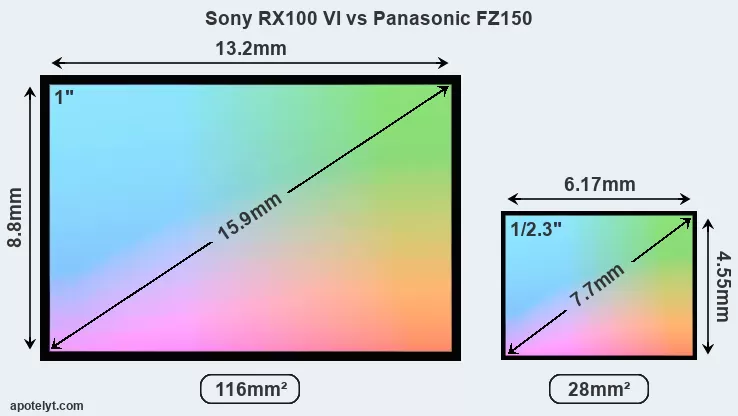
With 20MP, the RX100 VI offers a higher resolution than the FZ150 (12MP), but the RX100 VI nevertheless has larger individual pixels (pixel pitch of 2.41μm versus 1.53μm for the FZ150) due to its larger sensor. Moreover, the RX100 VI is a much more recent model (by 6 years and 9 months) than the FZ150, and its sensor will have benefitted from technological advances during this time that further enhance the light gathering capacity of its pixels. Coming back to sensor resolution, it should be mentioned that the FZ150 has no anti-alias filter installed, so that it can capture all the detail its sensor resolves.
The resolution advantage of the Sony RX100 VI implies greater flexibility for cropping images or the possibility to print larger pictures. The maximum print size of the RX100 VI for good quality output (200 dots per inch) amounts to 27.4 x 18.2 inches or 69.5 x 46.3 cm, for very good quality (250 dpi) 21.9 x 14.6 inches or 55.6 x 37.1 cm, and for excellent quality (300 dpi) 18.2 x 12.2 inches or 46.3 x 30.9 cm. The corresponding values for the Panasonic FZ150 are 20 x 15 inches or 50.8 x 38.1 cm for good quality, 16 x 12 inches or 40.6 x 30.5 cm for very good quality, and 13.3 x 10 inches or 33.9 x 25.4 cm for excellent quality prints.
The RX100 VI has on-sensor phase detect pixels, which results in fast and reliable autofocus acquisition even during live view operation.
The Sony Cyber-shot DSC-RX100 VI has a native sensitivity range from ISO 125 to ISO 12800, which can be extended to ISO 80-25600. The corresponding ISO settings for the Panasonic Lumix DMC-FZ150 are ISO 100 to ISO 3200, with the possibility to increase the ISO range to 100-6400.
In terms of underlying technology, the RX100 VI is build around a BSI-CMOS sensor, while the FZ150 uses a CMOS imager. Both cameras use a Bayer filter for capturing RGB colors on a square grid of photosensors. This arrangement is found in most digital cameras.
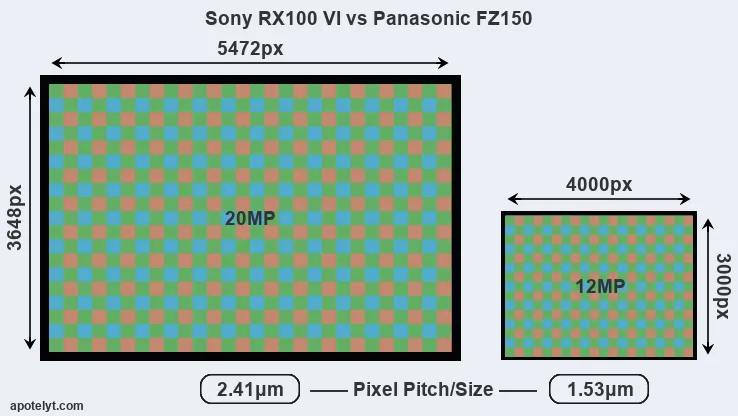
Consistent information on actual sensor performance is available from DXO Mark for many cameras. This service assesses and scores the color depth ("DXO Portrait"), dynamic range ("DXO Landscape"), and low-light sensitivity ("DXO Sports") of camera sensors, and also publishes an overall camera score. The following table provides an overview of the physical sensor characteristics, as well as the sensor quality measurements for a selection of comparators.

| Camera Model |
Sensor Class |
Resolution (MP) |
Horiz. Pixels |
Vert. Pixels |
Video Format |
DXO Portrait |
DXO Landscape |
DXO Sports |
DXO Overall |
||
|---|---|---|---|---|---|---|---|---|---|---|---|
| 1. | Sony RX100 VI | 1-inch | 20.0 | 5472 | 3648 | 4K/30p | 22.1 | 12.3 | 478 | 64 | |
| 2. | Panasonic FZ150 | 1/2.3 | 12.0 | 4000 | 3000 | 1080/60p | 19.4 | 10.9 | 132 | 40 | |
| 3. | Canon G5 X Mark II | 1-inch | 20.0 | 5472 | 3648 | 4K/30p | 22.2 | 12.4 | 583 | 65 | |
| 4. | Canon G7 X Mark III | 1-inch | 20.0 | 5472 | 3648 | 4K/30p | 22.2 | 12.4 | 583 | 65 | |
| 5. | Canon SX40 | 1/2.3 | 12.0 | 4000 | 3000 | 1080/24p | 19.6 | 10.9 | 409 | 41 | |
| 6. | Canon SX50 | 1/2.3 | 12.0 | 4000 | 3000 | 1080/24p | 20.3 | 11.2 | 179 | 47 | |
| 7. | Leica C-LUX | 1-inch | 20.0 | 5472 | 3648 | 4K/30p | 22.1 | 12.3 | 481 | 64 | |
| 8. | Leica V-LUX 5 | 1-inch | 20.0 | 5472 | 3648 | 4K/30p | 22.2 | 12.4 | 584 | 65 | |
| 9. | Panasonic FZ100 | 1/2.3 | 14.0 | 4320 | 3240 | 1080/60i | 19.4 | 10.7 | 306 | 39 | |
| 10. | Panasonic FZ200 | 1/2.3 | 12.0 | 4000 | 3000 | 1080/60p | 19.1 | 10.8 | 114 | 37 | |
| 11. | Panasonic LX5 | 1/1.7 | 10.0 | 3648 | 2736 | 720/60p | 19.6 | 10.8 | 132 | 41 | |
| 12. | Sony RX100 II | 1-inch | 20.0 | 5472 | 3648 | 1080/60p | 22.5 | 12.4 | 483 | 67 | |
| 13. | Sony RX100 III | 1-inch | 20.0 | 5472 | 3648 | 1080/60p | 22.4 | 12.3 | 495 | 67 | |
| 14. | Sony RX100 IV | 1-inch | 20.0 | 5472 | 3648 | 4K/30p | 22.8 | 12.6 | 591 | 70 | |
| 15. | Sony RX100 V | 1-inch | 20.0 | 5472 | 3648 | 4K/30p | 22.8 | 12.4 | 586 | 70 | |
| 16. | Sony RX100 VII | 1-inch | 20.0 | 5472 | 3648 | 4K/30p | 21.8 | 12.4 | 418 | 63 | |
| 17. | Sony ZV-1 | 1-inch | 20.0 | 5472 | 3648 | 4K/30p | 22.2 | 12.6 | 669 | 66 | |
| Note: DXO values in italics represent estimates based on sensor size and age. | |||||||||||
Many modern cameras are not only capable of taking still images, but also of capturing video footage. Both cameras under consideration are equipped with sensors that have a sufficiently high read-out speed for moving images, but the RX100 VI provides a higher video resolution than the FZ150. It can shoot video footage at 4K/30p, while the Panasonic is limited to 1080/60p.
Feature comparison
Apart from body and sensor, cameras can and do differ across a range of features. The two cameras under consideration are similar with respect to both having an electronic viewfinder. However, the one in the RX100 VI offers a substantially higher resolution than the one in the FZ150 (2359k vs 202k dots). The following table reports on some other key feature differences and similarities of the Sony RX100 VI, the Panasonic FZ150, and comparable cameras.

| Camera Model |
Viewfinder (Type or 000 dots) |
Control Panel (yes/no) |
LCD Specifications (inch/000 dots) |
LCD Attach- ment |
Touch Screen (yes/no) |
Max Shutter Speed * |
Max Shutter Flaps * |
Built-in Flash (yes/no) |
Built-in Image Stab |
||
|---|---|---|---|---|---|---|---|---|---|---|---|
| 1. | Sony RX100 VI | 2359 | n | 3.0 / 1229 | tilting | Y | 1/2000s | 24.0/s | Y | Y | |
| 2. | Panasonic FZ150 | 202 | n | 3.0 / 460 | swivel | n | 1/2000s | 12.0/s | Y | Y | |
| 3. | Canon G5 X Mark II | 2360 | n | 3.0 / 1040 | tilting | Y | 1/2000s | 30/s | Y | Y | |
| 4. | Canon G7 X Mark III | none | n | 3.0 / 1040 | tilting | Y | 1/2000s | 30/s | Y | Y | |
| 5. | Canon SX40 | 202 | n | 2.7 / 230 | swivel | n | 1/3200s | 10.3/s | Y | Y | |
| 6. | Canon SX50 | 202 | n | 3.0 / 461 | swivel | n | 1/2000s | 2.2/s | Y | Y | |
| 7. | Leica C-LUX | 2330 | n | 3.0 / 1240 | fixed | Y | 1/2000s | 10.0/s | Y | Y | |
| 8. | Leica V-LUX 5 | 2360 | n | 3.0 / 1240 | swivel | Y | 1/4000s | 12.0/s | Y | Y | |
| 9. | Panasonic FZ100 | 202 | n | 3.0 / 460 | swivel | n | 1/2000s | 11.0/s | Y | Y | |
| 10. | Panasonic FZ200 | 1312 | n | 3.0 / 460 | swivel | n | 1/4000s | 12.0/s | Y | Y | |
| 11. | Panasonic LX5 | optional | n | 3.0 / 460 | fixed | n | 1/4000s | 2.5/s | Y | Y | |
| 12. | Sony RX100 II | optional | n | 3.0 / 1229 | tilting | n | 1/2000s | 10.0/s | Y | Y | |
| 13. | Sony RX100 III | 1440 | n | 3.0 / 1229 | tilting | n | 1/2000s | 10.0/s | Y | Y | |
| 14. | Sony RX100 IV | 2359 | n | 3.0 / 1228 | tilting | n | 1/2000s | 16.0/s | Y | Y | |
| 15. | Sony RX100 V | 2359 | n | 3.0 / 1229 | tilting | n | 1/2000s | 24.0/s | Y | Y | |
| 16. | Sony RX100 VII | 2359 | n | 3.0 / 921 | tilting | Y | 1/2000s | 90.0/s | Y | Y | |
| 17. | Sony ZV-1 | none | n | 3.0 / 922 | swivel | Y | 1/2000s | 24.0/s | n | n | |
| Note: *) Information refers to the mechanical shutter, unless the camera only has an electronic one. | |||||||||||
One differentiating feature between the two cameras concerns the touch sensitivity of the rear screen. The RX100 VI has a touchscreen, while the FZ150 has a conventional panel. Touch control can be particularly helpful, for example, for setting the focus point.
Both cameras have an articulated rear screen that can be turned to be front-facing. This feature will be particularly appreciated by vloggers and photographers who are interested in taking selfies.The reported shutter speed information refers to the use of the mechanical shutter. Yet, some cameras only have an electronic shutter, while others have an electronic shutter in addition to a mechanical one. In fact, the RX100 VI is one of those camera that have an additional electronic shutter, which makes completely silent shooting possible. However, this mode is less suitable for photographing moving objects (risk of rolling shutter) or shooting under artificial light sources (risk of flickering).
Both the RX100 VI and the FZ150 have zoom lenses built in. The RX100 VI has a 24-200mm f/2.8-4.5 optic and the FZ150 offers a 25-600mm f/2.8-5.2 (focal lengths in full frame equivalent terms). Hence, the Sony provides a wider angle of view at the short end than the Panasonic, but less tele-photo reach at the long end. Both cameras offer the same maximum aperture.
The RX100 VI writes its imaging data to SDXC or Memory Stick PRO Duo cards, while the FZ150 uses SDXC cards. The RX100 VI supports UHS-I cards (Ultra High Speed data transfer of up to 104 MB/s), while the FZ150 cannot take advantage of Ultra High Speed SD cards.
Connectivity comparison
For some imaging applications, the extent to which a camera can communicate with its environment can be an important aspect in the camera decision process. The table below provides an overview of the connectivity of the Sony Cyber-shot DSC-RX100 VI and Panasonic Lumix DMC-FZ150 and, in particular, the interfaces the cameras (and selected comparators) provide for accessory control and data transfer.

| Camera Model |
Hotshoe Port |
Internal Mic / Speaker |
Microphone Port |
Headphone Port |
HDMI Port |
USB Port |
WiFi Support |
NFC Support |
Bluetooth Support |
||
|---|---|---|---|---|---|---|---|---|---|---|---|
| 1. | Sony RX100 VI | - | stereo / mono | - | - | micro | 2.0 | Y | Y | Y | |
| 2. | Panasonic FZ150 | Y | stereo / - | - | - | mini | 2.0 | - | - | - | |
| 3. | Canon G5 X Mark II | - | stereo / mono | - | - | micro | 3.1 | Y | - | Y | |
| 4. | Canon G7 X Mark III | - | stereo / mono | Y | - | micro | 3.1 | Y | - | Y | |
| 5. | Canon SX40 | Y | stereo / mono | - | - | YES | 2.0 | - | - | - | |
| 6. | Canon SX50 | Y | stereo / mono | - | - | mini | 2.0 | - | - | - | |
| 7. | Leica C-LUX | - | stereo / mono | - | - | micro | 2.0 | Y | - | - | |
| 8. | Leica V-LUX 5 | Y | stereo / mono | - | - | micro | 2.0 | Y | - | Y | |
| 9. | Panasonic FZ100 | Y | stereo / mono | - | - | mini | 2.0 | - | - | - | |
| 10. | Panasonic FZ200 | Y | stereo / mono | Y | - | mini | 2.0 | - | - | - | |
| 11. | Panasonic LX5 | Y | mono / mono | - | - | mini | 2.0 | - | - | - | |
| 12. | Sony RX100 II | Y | stereo / mono | - | - | micro | 2.0 | Y | Y | - | |
| 13. | Sony RX100 III | - | stereo / mono | - | - | micro | 2.0 | Y | Y | - | |
| 14. | Sony RX100 IV | - | stereo / mono | - | - | micro | 2.0 | Y | Y | - | |
| 15. | Sony RX100 V | - | stereo / mono | - | - | micro | 2.0 | Y | Y | - | |
| 16. | Sony RX100 VII | - | stereo / mono | Y | - | micro | 2.0 | Y | Y | Y | |
| 17. | Sony ZV-1 | Y | stereo / mono | Y | - | micro | 2.0 | Y | - | Y |
It is notable that the RX100 VI offers wifi support, while the FZ150 does not. Wifi can be a very convenient means to transfer image data to an off-camera location.
Both the RX100 VI and the FZ150 have been discontinued, but can regularly be found used on ebay. The FZ150 was replaced by the Panasonic FZ200, while the RX100 VI was followed by the Sony RX100 VII. Further information on the features and operation of the RX100 VI and FZ150 can be found, respectively, in the Sony RX100 VI Manual (free pdf) or the online Panasonic FZ150 Manual.
Review summary
So what is the bottom line? Is there a clear favorite between the Sony RX100 VI and the Panasonic FZ150? Which camera is better? The listing below highlights the relative strengths of the two models.

Arguments in favor of the Sony Cyber-shot DSC-RX100 VI:
- More detail: Offers more megapixels (20 vs 12MP) with a 32% higher linear resolution.
- Better moiré control: Has an anti-alias filter to avoid artificial patterns to appear in images.
- Better image quality: Features a larger and more technologically advanced imaging sensor.
- Richer colors: The sensor size advantage translates into images with better, more accurate colors.
- More dynamic range: Larger sensor captures a wider spectrum of light and dark details.
- Better low-light sensitivity: Larger sensor produces good images even in poorly lit environments.
- Better video: Provides higher definition movie capture (4K/30p vs 1080/60p).
- Better live-view autofocus: Features on-sensor phase-detection for more confident autofocus.
- More detailed viewfinder: Has higher resolution electronic viewfinder (2359k vs 202k dots).
- More detailed LCD: Has a higher resolution rear screen (1229k vs 460k dots).
- Fewer buttons to press: Is equipped with a touch-sensitive rear screen to facilitate handling.
- Faster burst: Shoots at higher frequency (24 vs 12 flaps/sec) to capture the decisive moment.
- Less disturbing: Has an electronic shutter option for completely silent shooting.
- Wider view: Has a wider-angle lens that facilitates landscape or interior shots.
- More compact: Is smaller (102x58mm vs 124x82mm) and thus needs less room in the bag.
- Less heavy: Is lighter (by 227g or 43 percent) and hence easier to carry around.
- Easier travel charging: Can be conveniently charged via its USB port.
- Easier file upload: Has wifi built in for automatic backup or image transfer to the web.
- Easier device pairing: Supports NFC for fast wireless image transfer over short distances.
- Easier wireless transfer: Supports Bluetooth for image sharing without cables.
- Faster buffer clearing: Has an SD card interface that supports the UHS-I standard.
- More modern: Reflects 6 years and 9 months of technical progress since the FZ150 launch.

Reasons to prefer the Panasonic Lumix DMC-FZ150:
- Maximized detail: Lacks an anti-alias filter to exploit the sensor's full resolution potential.
- More flexible LCD: Has a swivel screen for odd-angle shots in portrait or landscape orientation.
- More tele-reach: Has a longer tele-lens for perspective compression and subject magnification.
- Longer lasting: Gets more shots (410 versus 240) out of a single battery charge.
- Better lighting: Features a hotshoe and can thus hold and trigger an external flash gun.
- More affordable: Was introduced into a lower priced category (58 percent cheaper at launch).
- More heavily discounted: Has been around for much longer (launched in August 2011).
If the count of individual advantages (bullet points above) is taken as a guide, the RX100 VI is the clear winner of the match-up (22 : 7 points). However, the relevance of individual strengths will vary across photographers, so that you might want to apply your own weighing scheme to the summary points when reflecting and deciding on a new camera. A professional wildlife photographer will view the differences between cameras in a way that diverges from the perspective of a family photog, and a person interested in architecture has distinct needs from a sports shooter. Hence, the decision which camera is best and worth buying is often a very personal one.
How about other alternatives? Do the specifications of the Sony RX100 VI and the Panasonic FZ150 place the cameras among the top in their class? Find out in the latest Best Travel-Zoom Camera and Best Superzoom Camera listings whether the two cameras rank among the cream of the crop.
In any case, while the comparison of technical specifications can provide a useful overview of the capabilities of different cameras, it remains incomplete and does no justice, for example, to the way the RX100 VI or the FZ150 perform in practice. User reviews, such as those found at amazon, can sometimes inform about these issues, but such feedback is often incomplete, inconsistent, and biased.
Expert reviews
This is where reviews by experts come in. The table below provides a synthesis of the camera assessments of some of the best known photo-gear review sites (amateurphotographer [AP], cameralabs [CL], digitalcameraworld [DCW], dpreview [DPR], ephotozine [EPZ], photographyblog [PB]). As can be seen, the professional reviewers agree in many cases on the quality of different cameras, but sometimes their assessments diverge, reinforcing the earlier point that a camera decision is often a very personal choice.

| Camera Model |
AP score |
CL score |
DCW score |
DPR score |
EPZ score |
PB score |
Camera Launch |
Launch Price (USD) |
Street Price |
||
|---|---|---|---|---|---|---|---|---|---|---|---|
| 1. | Sony RX100 VI | 4.5/5 | + + | .. | 83/100 | 4/5 | 4.5/5 | Jun 2018 | 1,199 | ebay.com | |
| 2. | Panasonic FZ150 | 3/5 | + + | .. | 76/100 | 4/5 | 4.5/5 | Aug 2011 | 499 | ebay.com | |
| 3. | Canon G5 X Mark II | 4/5 | + | 4/5 | 82/100 | .. | 4/5 | Jul 2019 | 899 | ebay.com | |
| 4. | Canon G7 X Mark III | .. | + + | 4/5 | 81/100 | 4/5 | .. | Jul 2019 | 749 | amazon.com | |
| 5. | Canon SX40 | .. | + | .. | .. | 4.5/5 | 4/5 | Sep 2011 | 429 | ebay.com | |
| 6. | Canon SX50 | 3/5 | + + | .. | 72/100 | 4.5/5 | 4.5/5 | Sep 2012 | 429 | ebay.com | |
| 7. | Leica C-LUX | .. | .. | 3.5/5 | .. | 4.5/5 | 4/5 | Jun 2018 | 1,049 | ebay.com | |
| 8. | Leica V-LUX 5 | .. | .. | .. | .. | 4/5 | 4/5 | Jul 2019 | 1,249 | amazon.com | |
| 9. | Panasonic FZ100 | .. | + | .. | .. | 4.5/5 | 4.5/5 | Jul 2010 | 499 | ebay.com | |
| 10. | Panasonic FZ200 | 3/5 | + + | .. | 80/100 | 4.5/5 | 4.5/5 | Jul 2012 | 599 | ebay.com | |
| 11. | Panasonic LX5 | 4/5 | + | .. | 73/100 | 4.5/5 | 4.5/5 | Jul 2010 | 499 | ebay.com | |
| 12. | Sony RX100 II | 5/5 | + + | .. | 79/100 | 4.5/5 | 4.5/5 | Jun 2013 | 749 | ebay.com | |
| 13. | Sony RX100 III | 5/5 | + + | .. | 82/100 | 4.5/5 | 5/5 | May 2014 | 799 | ebay.com | |
| 14. | Sony RX100 IV | 4.5/5 | + + | .. | 85/100 | 4/5 | 4.5/5 | Jun 2015 | 999 | ebay.com | |
| 15. | Sony RX100 V | 4.5/5 | + + | .. | 83/100 | 4/5 | 4.5/5 | Oct 2016 | 999 | ebay.com | |
| 16. | Sony RX100 VII | 4.5/5 | .. | 4/5 | .. | 4/5 | 5/5 | Jul 2019 | 1,199 | amazon.com | |
| 17. | Sony ZV-1 | 4/5 | + | 4/5 | 85/100 | 4/5 | 4.5/5 | May 2020 | 799 | ebay.com | |
| Note: (+ +) highly recommended; (+) recommended; (o) reviewed; (..) not available. | |||||||||||
The review scores listed above should be treated with care, though. The assessments were made in relation to similar cameras of the same technological generation. A score, therefore, has to be seen in close connection to the price and market introduction time of the camera, and rating-comparisons among cameras that span long time periods or concern very differently equipped models make little sense. Also, kindly note that some of the listed sites have over time developped their review approaches and their reporting style.

Check RX100 VI offers at
ebay.com

Check FZ150 offers at
ebay.com
Other camera comparisons
Did this review help to inform your camera decision process? In case you are interested in seeing how other cameras pair up, just make a corresponding selection in the search boxes below. There is also a set of direct links to comparison reviews that other users of the CAM-parator app explored.
- Canon SX620 vs Sony RX100 VI
- Leica V-LUX 2 vs Panasonic FZ150
- Leica X Typ 113 vs Panasonic FZ150
- Nikon D200 vs Sony RX100 VI
- Nikon D3500 vs Sony RX100 VI
- Nikon Z8 vs Sony RX100 VI
- Olympus E-5 vs Sony RX100 VI
- Panasonic FZ150 vs Panasonic G100
- Panasonic FZ150 vs Sony HX95
- Panasonic FZ150 vs Sony RX0 II
- Panasonic FZ150 vs Sony RX1R II
- Panasonic G10 vs Sony RX100 VI
Specifications: Sony RX100 VI vs Panasonic FZ150
Below is a side-by-side comparison of the specs of the two cameras to facilitate a quick review of their differences and common features.
| Camera Model | Sony RX100 VI | Panasonic FZ150 |
|---|---|---|
| Camera Type | Fixed lens compact camera | Fixed lens compact camera |
| Camera Lens | 24-200mm f/2.8-4.5 | 25-600mm f/2.8-5.2 |
| Launch Date | June 2018 | August 2011 |
| Launch Price | USD 1,199 | USD 499 |
| Sensor Specs | Sony RX100 VI | Panasonic FZ150 |
| Sensor Technology | BSI-CMOS | CMOS |
| Sensor Format | 1" Sensor | 1/2.3" Sensor |
| Sensor Size | 13.2 x 8.8 mm | 6.17 x 4.55 mm |
| Sensor Area | 116.16 mm2 | 28.0735 mm2 |
| Sensor Diagonal | 15.9 mm | 7.7 mm |
| Crop Factor | 2.7x | 5.6x |
| Sensor Resolution | 20 Megapixels | 12 Megapixels |
| Image Resolution | 5472 x 3648 pixels | 4000 x 3000 pixels |
| Pixel Pitch | 2.41 μm | 1.53 μm |
| Pixel Density | 17.18 MP/cm2 | 42.74 MP/cm2 |
| Moiré control | Anti-Alias filter | no AA filter |
| Movie Capability | 4K/30p Video | 1080/60p Video |
| ISO Setting | 125 - 12,800 ISO | 100 - 3,200 ISO |
| ISO Boost | 80 - 25,600 ISO | 100 - 6,400 ISO |
| Image Processor | BIONZ X | Venus FHD |
| DXO Sensor Quality (score) | .. | 40 |
| DXO Color Depth (bits) | .. | 19.4 |
| DXO Dynamic Range (EV) | .. | 10.9 |
| DXO Low Light (ISO) | .. | 132 |
| Screen Specs | Sony RX100 VI | Panasonic FZ150 |
| Viewfinder Type | Electronic viewfinder | Electronic viewfinder |
| Viewfinder Field of View | 100% | 100% |
| Viewfinder Magnification | 0.59x | |
| Viewfinder Resolution | 2359k dots | 202k dots |
| LCD Framing | Live View | Live View |
| Rear LCD Size | 3.0inch | 3.0inch |
| LCD Resolution | 1229k dots | 460k dots |
| LCD Attachment | Tilting screen | Swivel screen |
| Touch Input | Touchscreen | no Touchscreen |
| Shooting Specs | Sony RX100 VI | Panasonic FZ150 |
| Focus System | On-Sensor Phase-detect | Contrast-detect AF |
| Manual Focusing Aid | Focus Peaking | no Peaking Feature |
| Continuous Shooting | 24 shutter flaps/s | 12 shutter flaps/s |
| Electronic Shutter | up to 1/32000s | no E-Shutter |
| Fill Flash | Built-in Flash | Built-in Flash |
| Storage Medium | MS or SDXC cards | SDXC cards |
| Single or Dual Card Slots | Single card slot | Single card slot |
| UHS card support | UHS-I | no |
| Connectivity Specs | Sony RX100 VI | Panasonic FZ150 |
| External Flash | no Hotshoe | Hotshoe |
| USB Connector | USB 2.0 | USB 2.0 |
| HDMI Port | micro HDMI | mini HDMI |
| Wifi Support | Wifi built-in | no Wifi |
| Near-Field Communication | NFC built-in | no NFC |
| Bluetooth Support | Bluetooth built-in | no Bluetooth |
| Body Specs | Sony RX100 VI | Panasonic FZ150 |
| Battery Type | Sony NP-BX1 | Panasonic DMW-BMB9 |
| Battery Life (CIPA) | 240 shots per charge | 410 shots per charge |
| In-Camera Charging | USB charging | no USB charging |
| Body Dimensions |
102 x 58 x 43 mm (4.0 x 2.3 x 1.7 in) |
124 x 82 x 92 mm (4.9 x 3.2 x 3.6 in) |
| Camera Weight | 301 g (10.6 oz) | 528 g (18.6 oz) |

Check RX100 VI offers at
ebay.com

Check FZ150 offers at
ebay.com
Did you notice an error on this page? If so, please get in touch, so that we can correct the information.

